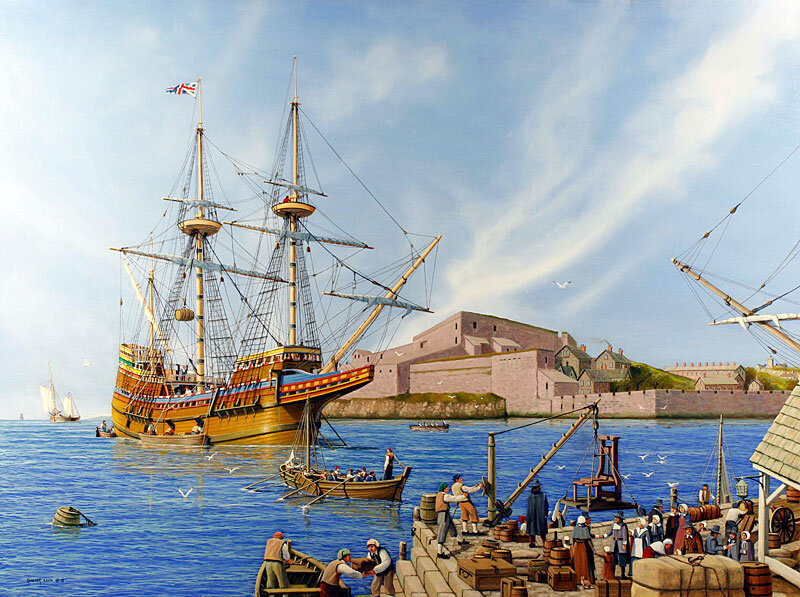All Aboard; MAYFLOWER, Plymouth, England, 1620
oil, 27" x 36"
SOLD
In the year 1620, a small aging merchant ship set out across the Atlantic Ocean for the continent of North America. Under the command of Captain Christopher Jones, the vessel carried over 100 crew and passengers who were a group of religious dissenters escaping from the tight control of Britain to find more freedom in the ‘New World.’
It is commonly assumed that the ship sailed from Plymouth and made the crossing when, in fact, she left England a total of three separate times. The first was from Southampton, which, when two days out Mayflower’s consort vessel, the Speedwell, sprung a leak, necessitated a return that brought the parties back into Dartmouth where shipwrights attempted a repair, caulking the leaking areas. Both ships left Dartmouth and, once again, a short time after, Speedwell again was leaking so badly that it was feared by all that she would founder. The decision was made to return again, this time to Plymouth, and that the Mayflower would continue alone. Some of the passengers became discouraged and elected to remain behind as the remainder arranged to have themselves and their belongings transferred over to Mayflower. Along with their departure date being so delayed, worries were surfacing about the season of storms which was a concern in the North Atlantic at that time of year. Also, the ship would now be extremely overcrowded with the burden of more passengers and their supplies being loaded from the Speedwell, now remaining behind.
This painting shows the Mayflower anchored in Plymouth with passengers and crew rushing to transfer over to Mayflower from Speedwell so they could get back to sea as soon as possible. In the background can be seen the walled barrier built two hundred years earlier to protect the town of Plymouth which can still be seen today. To the far right, the Speedwell’s bowsprit and spritsail can be seen poking out from behind the supply shed at bottom right. The passengers and town officials are checking for the last time documents that will allow the dissenters to leave England. Others are greeting friends from each ship as crew load a dockful of barrels, chests and other belongings to be brought out to the Mayflower. On the far left of the quay can be seen two men with 17th century lifting hoist, which is being used to load a printing press onto the barge below. This press was to figure prominently when, during a storm on the crossing, Mayflower’s main beam broke, opening deck seams and causing water to pour into her hull. By cranking the screw mechanism up under the beam, it allowed carpenters to shore up the break with support beams, possibly saving the lives of all on board. The press is copied from numerous diagrams found online of 17th century presses.
There were animals on board Mayflower as well and if one looks, close, you will see a cat patiently sitting amongst the confusion of possessions on the dock. To the far left, crew are loading supplies and the ship’s boat, a shallop, is in the midground taking a few ‘Pilgrim Fathers’ over to the vessel. On the quarterdeck the captain is keeping a sharp eye on the proceedings as passengers are standing about watching the loading of items through the four cannon ports from a longboat. A cask of perhaps water or even salt beef is hanging in midair from a block and tackle sling rigged from the main yard to be lowered into the hold. The English Jack is flying from the main truck.
This painting was done to honor the celebration in 2020 of the 400th anniversary of the Mayflower Voyage and the men and women whose arrival on these shores planted the seed which would become the United States of America.
